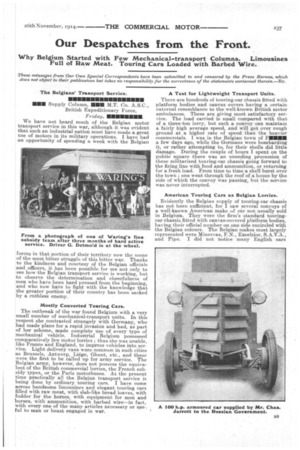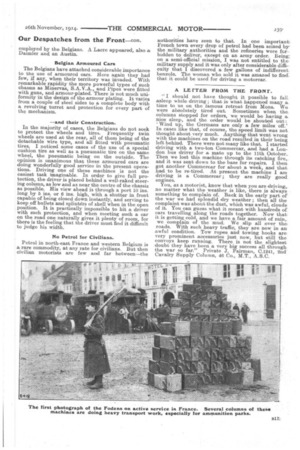Our Despatches from the Front.
Page 13

Page 15

If you've noticed an error in this article please click here to report it so we can fix it.
Why Belgium Started with Few Mechanical-transport Columns. Limousines Full of Raw Meat. Touring Cars Loaded with Barbed Wire.
These messages from Our Own Special Correspondents have been submitted to and censored by the Press Bureau, which does not object to their publication but takes no responsibility for the correctness of the statements contained therein.—ED.
The Belgians' Transport Service.
MMOMMIHMENIMMIMIN Min Supply Column, MEM M.T. Co. A.S.C., British Expeditionary Force,
We have not heard much of the Belgian motor transport service in this war, although it was evident that such an industrial nation must have made a great use of motors in its military operations. I have had an opportunity of spending a week with the Belgian forces in that portion of their territory now the scene of the most bitter struggle of this bitter war. Thanks to the kindness and courtesy of the Belgian officials and officers, it has been possible for me not only to see how•the Belgian transport service is working, but to observe the determination and cheerfulness of men who have been hand pressed from the beginning, and who now have to fight with the knowledge that the greater portion of their country has been sacked by a, ruthless enemy.
Mostly Converted Touring Cars.
The outbreak of the war found Belgium with a very small number of mechanical-transport units. In this respect she contrasted strangely with Germany, who had made plans for a rapid invasion and had, as part of her scheme, made complete use of every type of mechanical vehicle. Industrial Belgium possessed comparatively few motor lorries ; thus she was unable, like France and England, to impress vehicles into service. Light delivery vans were common in such cities as Brussels, Antwerp, Liege, Ghent, etc., and these were the first to be called up for army service. The Belgian army, however, does not possess the equivalent of the British commercial lorries, the French subsidy types, or the Paris motorbuses. At the present time practically all the Belgian transport service is being done by ordinary touring cars. I have come across handsome limousines and elegant touring cars filled with raw meat, with slab-like bread loaves, with fodder for the horses, with equipment for men and horses, with ammunition, with barbed wire—in fact, with every one of the many articles necessary or useful to man or beast engaged in war. A Test for Lightweight Transport Units.
There are hundreds of touring-car chassis fitted with platform bodies and canvas covers having a certain external resemblance to the well-known British motor ambulances. These are giving most satisfactory service. The load carried is small compared with that of a three-ton lorry, but such a convoy can maintain a fairly high average speed, and will get over rough ground at a higher rate of speed than the heavier commercials. I was in the Belgian town of AIM a few days ago, while the Germans were bombarding it, or rather attempting to, for their shells did little damage. During the couple of hours I spent on the public square there was an unending procession of these militarized touring-car chassis going forward to the firing line with food and ammunition, or returning for a fresh load. From time to time a shell burst over the town ; one went through the roof of a house by the side of which the convoy was passing, but the service was never interrupted.
American Touring Cars as Belgian Lorries.
Evidently the Belgian supply of touring-car chassis has not been sufficient, for I saw several convoys of a well-known American make of ear not usually sold in Belgium. They were the firm's standard touringcar chassis fitted with canvas-covered platform bodies, having their official number on one side encircled with the Belgian colours. The Belgian makes most largely represented were Minervas, F.N., Excelsior, S.A.V.A., and Pipe. I did not notice many English cars employed by the Belgians. A Lacre appeared, also a. Daimler and an Austin.
Belgian Armoured Cars The Belgians have attached considerable importance to the use of armoured cars. Here again they had few, if any, when their territory was invaded. With remarkable rapidity the more powerful types of such chassis as Minervas, S.A.V.A., and Pipes were fitted with guns, and armour-plated. There is not much uniformity in the design of the armour plating. It varies from a couple of steel sides to a complete body with a revolving turret and protection for every part of the mechanism..
—and their Construction.
In the majority of cases, the Belgians do not seek to protect the wheels and tires. Frequently twin wheels are used at the rear, all of them being of the detachable wire type, and all fitted with pneumatic tires. I noticed some cases of the use of a special cushion tire as well as a pneumatic tire on the same wheel, the pneumatic being on the outside. The opinion is unanimous that these armoured cars are doing wonderfully good service in the present operations. Driving one of these machines is not the easiest task imaginable. In order to give full protection, the driver is placed behind a well-raked steering column, as low and as near the centre of the chassis as possible. His view ahead is through a port 10 ins. long by 5 ins. or 6 ins, high, with a shutter in front capable of being closed down instantly, and serving to keep off bullets and splinters of shell when in the open position. It is practically impossible to hit a driver with such protection, and when meeting such a car on the road one naturally gives it plenty of room, for there is the feeling that the driver must find it difficult to judge his width.
No Petrol for Civilians.
Petrol in north-east France and western Belgium is a rare commodity, at any rate for civilians. But then civilian motorists are few and far between—the authorities have seen to that. In one important; French town every drop of petrol had been seized bythe military authorities and the refineries were forbidden to deliver, except on an army order. Being: on a semi-official mission, I was not entitled to the military supply and it was only after considerable difficulty that I discovered a, few gallons of indifferent benzole. The woman who sold it was amazed to find. that it could be used for driving a motorcar.
A LE CTER FROM THE FRONT.
" I should not have thought it possible to fall_ asleep while driving ; that is what happened may a time to us on the famous retreat from Mona. We were absolutely tired out. Sometimes when the columns stopped for orders, we would be having a nice sleep, and the order would be shouted out : Wind up, the Germans are only a few miles off.' In cases like that, of course, the speed limit was not thought about very much. Anything that went wrong with the machines on the road resulted in their being left behind. There were not many like that. I started driving with a two-ton Commercar, and had a London bus driver for a mate up to the 11th October.. Then we lost this machine through its catching fire,. and it was sent down to the base for repairs. I then got another Commercar for about a week, and that had to be re-tired. At present the machine I am driving is a Commerear they are really good engines, You, as a motorist, know that when you are driving,. no matter what the weather is like, there is always • something to complain of. Back in the early part of the war we had splendid dry weather ; then all the complaint was about the dust, which was awful, clouds of it. You can guess what it meant with hundreds of cars travelling along the roads together. Now that: it is getting cold, and we have a fair amount of rain„ we complain of the mud. We slip all over the roads. With such heavy traffic, they are now in an awful condition. Tow ropes and towing hooks are very prominent accessories just now, but still the convoys keep running. There is not the slightest doubt they have been a, very big success all through. the war SO far." Private J. Fairman, C.1241, 2nd Cavalry Supply Column, 46 Co., M. T., A.S.C.


















